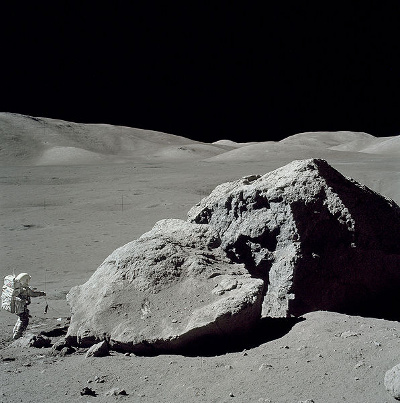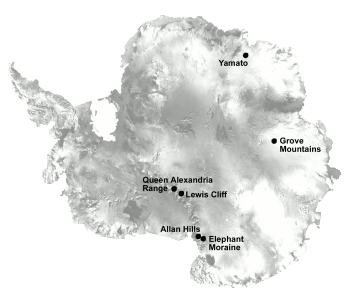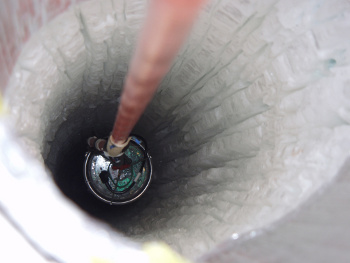IceCube
May 21, 2012
Scientists will go to the ends of the
Earth for their
science; and some, such as
Harrison Schmitt, will go even farther. Schmitt, a
geologist, was a member of the
Apollo 17 crew, and the last
astronaut to step onto the
Moon. The last person to depart from the moon was
Eugene Cernan, the mission commander. Unlike any of his astronaut colleagues, Schmitt was never in the
military.

Apollo astronaut, Harrison Schmitt, on the moon, as photographed by Eugene Cernan.
The Apollo mission landed at Taurus–Littrow, a lunar valley, found to have feldspar over a basalt base.
(NASA image, via Wikimedia Commons))
Antarctica has been a hot spot for science. The
snow and
ice covering this
continent is an ideal landscape for
finding meteorites, since there is a sharp contrast between the usually black
meteorites and the white background. There are also processes that cause the meteorites to collect in particular
topographic features, and the meteorites are less contaminated by
biological materials and natural processes.[1]

A few meteorites have been identified as coming from Mars because of their elemental and isotopic compositions. Several of these were found in Antarctica.
(NASA image by
Anita Dodson). [2)]
Other research in Antarctica involves the many
sub-glacial lakes that are buried under
kilometers of ice. I wrote about these in a
previous article (Lake Ellsworth Antarctica, October 18, 2011). These lakes are
liquid because of the
geothermal heat of the
Earth and the
pressure of the ice layer, and they've been isolated from the rest of the world for hundreds of thousands, to millions, of years.
There's the possibility that archaic
lifeforms will be found in the
water or
sediment of these lakes.
Lake Vostok, the largest sub-glacial lake, has been isolated for fifteen million years.
Russian scientists have been drilling down into Lake Vostok, four
kilometers from the surface, for more than twenty years. They plan to enter the lake at the end of the year and launch an underwater
robot to collect sediment from the bottom.[3]
The
particle physicists and
astrophysicists have joined the
planetary scientists and the
biologists in using Antarctica as a
research laboratory by creating a huge
neutrino detector called
IceCube. The
cube designation is apt, since the detector is a
cubic kilometer block of ice about two kilometers below the
National Science Foundation's Amundsen-Scott South Pole Station.[4-8]
The ice creates an
optical signal of the passage of
muons that are created when neutrinos collide with
atomic nuclei in the ice. There are 5,160 optical sensors that detect this light. These are on 86 strings dangling into holes drilled into the ice.[4] Drilling of the 86 string holes occurred over a span of six construction
seasons (see photo).[5]

One of eighty-six IceCube bore holes. Each hole required about two days to drill, and installing the sensor string occupied another half day.
The final hole was completed on December 18, 2010.[5]
(NSF photo by IceCube Collaboration))
These sensors were designed to withstand
temperatures down to –55 °
C, and
pressures to 700
atmospheres. Each detector was limited to five
watts of
power, since it's hard to
generate electricity at the South Pole (5,160 sensors x 5 watt/sensor = 25.8 kilowatts).[5]
Ice cube sees a lot of muons, but most are not the muons that scientists really seek. There are a million times more downwards than upwards moving muons, and the downwards ones are
noise caused by
cosmic rays hitting Earth's
atmosphere or surface. The high quality muons are the ones moving upwards. These are the ones that are formed by neutrinos that have traveled completely through the Earth, and their sources are in the northern sky.[5]
ICE cube has already proven its utility to
astrophysics by providing data that cosmic rays are not produced by the high energy gamma rays from so-called
gamma ray bursters (GRB). These can release more energy in a few hours than our
Sun will produce in its lifetime.[6] If gamma ray bursters produced cosmic rays, there would be a neutrino signature associated with a gamma ray burst. The gamma ray bursts are detected by satellites. No correlation was found, so cosmic rays are more likely to come from
active galactic nuclei, where
supermassive black holes reside.[6]
For 300 GRBs recorded over a two year interval, IceCube should have detected about eight neutrinos, but none were detected.[6]
Spencer Klein of
Lawrence Berkeley National Laboratory, a long-time member of the IceCube Collaboration, is quoted as saying,
"According to a leading model, we would have expected to see 8.4 events corresponding to GRB production of neutrinos in the IceCube data used for this search... We didn't see any, which indicates that GRBs are not the source of ultra-high-energy cosmic rays."[4]
Gamma ray bursts were
first detected, unexpectedly, by
satellites designed to detect
nuclear weapon tests on Earth. There is now a network of many of these satellites designed to obtain a precise direction of such bursts. Ice cube is capable of detecting neutrino direction to about one degree;[4] that is, it can determine a position that's precise to about 25
parts per million.
There's even talk of the next version of IceCube, this one involving a hundred times the volume of ice![5] My proposal for this calls for an army of wireless, burrowing
nanobots. It's probably the only way this could be done. They might be powered by
blue-green lasers on the surface.
A paper on the gamma ray burster IceCube experiment appears in Nature.[8]
References:
- ANSMET, The Antarctic Search for Meteorites program, web site at Case Western Reserve University.
- Appendix IV of The Mars Meteorite Compendium by Charles Meyer, Astromaterials Research & Exploration Science, Lyndon B. Johnson Space Center (JSC #27672 Revision C).
- Searching for new forms of life on Earth, The Voice of Russia, April 17, 2012.
- Paul Preuss, "Where Do the Highest-Energy Cosmic Rays Come From? Probably Not from Gamma-Ray Bursts," Lawrence Berkeley National Laboratory Press Release, April 18, 2012.
- Spencer Klein, "IceCube: The Polar Particle Hunter - Searching Antarctica for the frozen paths of cosmic-ray neutrinos, IEEE Spectrum, February 2011.
- Jason Palmer, "'Extreme Universe' puzzle deepens," BBC News, April 19, 2012.
- IceCube Neutrino Observatory explores origin of cosmic rays, University of Wisconsin Press Release, April 18, 2012.
- IceCube Collaboration, "An absence of neutrinos associated with cosmic ray acceleration in gamma-ray bursts," Nature, vol. 484, no. 7394 (April 19, 2012), pp. 351-354.
Permanent Link to this article
Linked Keywords: Scientist; Earth; science; Harrison Schmitt; geologist; Apollo 17; astronaut; Moon; Eugene Cernan; military; Taurus–Littrow; feldspar; basalt; NASA; Wikimedia Commons; Antarctica; snow; ice; continent; meteorite; topography; topographic; biological; Martian meteorite; element; isotope; isotopic; Anita Dodson; sub-glacial lake; kilometer; liquid; geothermal heat; Earth; pressure; organism">lifeform; water; sediment; Lake Vostok; Russian; robot; particle physics; particle physicist; astrophysics; astrophysicist; planetary scientist; biologist; research laboratory; neutrino detector; IceCube Neutrino Observatory; Ice Cube; cube; cubic kilometer; National Science Foundation; Amundsen-Scott South Pole Station; optical; signal; muon; atomic nucleus; season; NSF; IceCube; temperature; Celsius; C; pressure; atmosphere; watt; power; electricity generation; noise; cosmic ray; astrophysics; gamma ray burster; Sun; active galactic nucleus; supermassive black hole; Spencer Klein; Lawrence Berkeley National Laboratory; history of gamma-ray burst research; satellite; nuclear weapon test; parts per million; nanobot; blue-green laser.